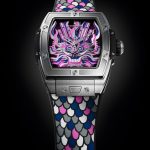Barbie, Greta Gerwig’s paean to the original glamor girl, represents a feat of studio filmmaking firing on all cylinders, a Hollywood production of the first order. From the committed performances of Margot Robbie, Ryan Gosling, and their troupe of Barbies and Kens to the daffy humor to the musical numbers, a charming showbiz spirit perks up the action on screen, and the world in which they inhabit is no less vibrant. Barbie Land stands as a candy-colored, eye-popping utopia of backlot beauty. But the plastic, fantastic surfaces of its setting are far removed from the muted muddiness of the Marvel Cinematic Universe, Disney’s deeply uncanny photorealistic remake series, and other standard-bearers for the modern blockbuster default aesthetic.
Gerwig likes to wear her influences on her sleeve, and as she’s gushed about her admiration for The Wizard of Oz, Singin’ in the Rain, and other classics from the golden age when posters shouted “In Glorious Technicolor!” The eye-popping hues of those films resulted from the groundbreaking “three-strip” camera, which created some of history’s most ravishing moving images through a clever innovation. A beam-splitter divided the light coming in through the lens into two, which passed through colored filters onto three strips of black-and-white film negative. One would record green, the other two would be sandwiched together to capture red and blue, and when combined through dye processes, they’d form the full spectrum of a supercharged rainbow.
Gerwig wanted to recapture this lustrous jewel-tone brilliance for Barbie—but three-strip Technicolor shooting has been impossible since the ‘50s. Enter cinematographer Rodrigo Prieto, who warmly greeted the prospect of a new challenge in a three-decade career that’s previously paired him with Martin Scorsese, Spike Lee, and Alejandro González Iñárritu. “For me, this was a stretch,” he tells GQ from his home in Mexico City. “It’s a total break with everything else I’ve done, which is what I loved about it.”
Prieto and his closest collaborators had no choice but to devise their own process for ground-up creation of the film’s palette, dubbed TechnoBarbie by Gerwig in a nod to their analog forebears. He had come to the table with a handful of ideas about the temperature and texture of the overall look: one, that Barbie Land should have a “boxed-in” feeling at once overtly fake to us and real to the characters, and two, that it should also have an “innocence.” (Prieto describes this as “when, as a kid, you open up a present to find a toy you’ve been wanting.”) He saw uniformity as the key to both and set out to find an all-purpose tone for each color, as if the “saturated, less nuanced” greens of the grass and trees were both manufactured at the same toy factory. (Warren Beatty and his director of photography Vittorio Storaro did something similar on 1990’s Dick Tracy, limiting themselves to a single blue, purple, etc. to emulate old-school comic book printing.)
“We did talk about shooting the whole thing on film,” Prieto says. “Then I had this idea that because toys are pristine, they’re clean, they have no brain, that all of this would make digital appropriate for Barbie Land.”



